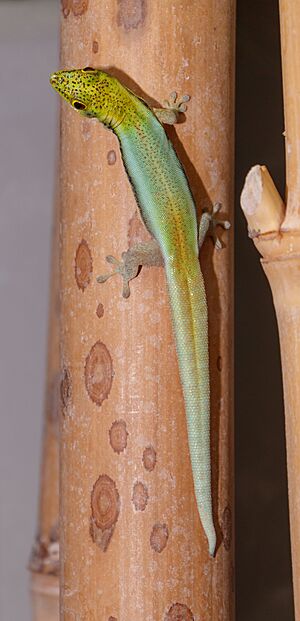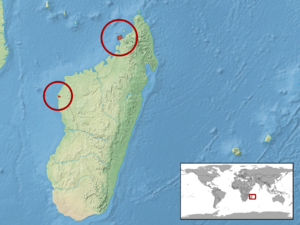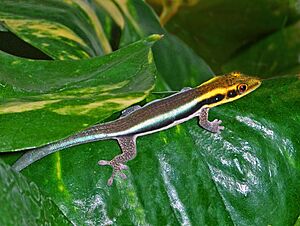Yellow-headed day gecko facts for kids
Quick facts for kids Yellow-headed day gecko |
|
|---|---|
 |
|
| Conservation status | |
| Scientific classification | |
| Genus: |
Phelsuma
|
| Species: |
klemmeri
|
 |
|
The yellow-headed day gecko (Phelsuma klemmeri) is a tiny, bright lizard. People also call it Klemmer's day gecko, the neon day gecko, or the cheerful day gecko. These geckos are active during the day. They belong to the gecko family, Gekkonidae. This special gecko lives only in northwestern Madagascar. It likes to live in bamboo forests near the coast. The yellow-headed day gecko eats insects and sweet nectar. Sadly, it is an endangered species.
Contents
What's in a Name?
The scientific name for this gecko is klemmeri. This name was chosen to honor a German scientist. His name was Konrad Klemmer, and he studied reptiles and amphibians.
Amazing Gecko Features
The yellow-headed day gecko is very small. It grows to be about 3.25 to 3.75 inches long, including its tail. Its body is slender and its snout is long.
- Body Color: The upper and middle parts of its back are a beautiful turquoise blue. The lower back is light brown. Most of its tail is also turquoise blue.
- Flat Body: A cool thing about this gecko is its body. It is flattened from side to side.
- Yellow Head: Its head is bright yellow, which is how it got its common name.
- Eye Markings: There is a dark black spot right behind its eye. A black stripe then runs from this spot all the way to its back legs.
- Legs and Toes: Its legs and toes have brown speckles.
- Underbelly: The underside of its body is grayish white.
- Telling Males from Females: You can easily tell male geckos from females. Males have orange color around their femoral pores. These are tiny pores on their thighs.
Where Do These Geckos Live?
The yellow-headed day gecko lives in northwestern Madagascar. They are found along the coast. So far, they have only been seen in two main areas. These are the Ampasindava Peninsula near Antsatsaka and close to Mandrozo Lake.
Gecko Homes in Bamboo Forests
These geckos mostly live in bamboo forests. They sometimes share their homes with other gecko types. These include the Phelsuma seippi and Phelsuma madagascariensis grandis. Yellow-headed day geckos are most often found on yellow bamboo stalks. But they can also be seen on green bamboo or other plants nearby. If they feel scared, they will quickly hide. They will squeeze into narrow cracks inside the bamboo.
What Do Geckos Eat?
The yellow-headed day gecko eats many different things. They enjoy various insects and other small creatures without backbones. They also love to lick soft, sweet fruits. Pollen and nectar from flowers are also a favorite treat for them.
Daily Gecko Life
These geckos are mostly active during the day. This means they are diurnal. They enjoy basking in the sun to warm up. Yellow-headed day geckos often live in small groups.
Reproduction and Life Cycle
Female yellow-headed day geckos lay two eggs at a time. They carefully hide these eggs inside bamboo stalks. If the temperature is about 27 degrees Celsius (80.6 degrees Fahrenheit), the baby geckos will hatch. This usually happens after about 39 to 52 days. When they hatch, each baby gecko is very tiny. They measure about 22 to 29 millimeters (less than 1.5 inches) long.
Geckos in Human Care
The yellow-headed day gecko is very popular. Many people breed them in captivity. This means they are raised by humans, not caught from the wild. The IUCN (a group that studies endangered animals) believes that most of these geckos are now bred this way. This helps protect the wild population. If they are cared for well, these geckos can live for up to 15 years.



